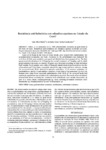Please use this identifier to cite or link to this item:
http://www.alice.cnptia.embrapa.br/alice/handle/doc/515257| Title: | Resistência anti-helmíntica em rebanhos caprinos no estado do Ceará. |
| Authors: | VIEIRA, L. da S.  CAVALCANTE, A. C. R.   |
| Affiliation: | Luiz da Silva Vieira, CNPC; Antônio Cézar Rocha Cavalcante, CNPC. |
| Date Issued: | 1999 |
| Citation: | Pesquisa Veterinária Brasileira, Rio de Janeiro, v. 19, n. 3/4, p. 99-103, 1999. |
| Description: | Um levantamento em nível de campo sobre resistência anti-helmíntica em nematódeos gastrintestinais de caprinos foi realizado em 34 rebanhos no Estado do Ceará. Em cada rebanho foram separados 30 cabritos, de ambos os sexos, com idade variando de 1 a 6 meses, os quais foram individualmente pesados, identificados e distribuídos em três tratamentos: 1) Oxfendazole na dose de 4,75mg/kg; 2) Levamisole na dose de 7,5 mg/kg e 3) Controle (não medicado). Os anti-helmínticos foram administrados de acordo com o peso individual de cada animal e, a dosagem utilizada para cada produto foi a recomendada pelo laboratório fabricante. Foram colhidas fezes dos animais de todos os tratamentos, para OPG e coprocultura, no dia da medicação e 7 dias após. Dos 34 rebanhos avaliados, 7 (20,6%) apresentaram resistência aos imidazóis, 6 (17,6%) aos benzimidazóis e 12 (35,3%) revelaram resistência múltipla. Apenas em 9 rebanhos (26,5%), os nematódeos foram sensíveis aos anti-helmínticos avaliados. Através do questionário aplicado detectou-se que 52,9% dos caprinocultores entrevistados usavam anti-helmínticos de amplo espectro. Os resultados das coproculturas mostraram que os gêneros sobreviventes à medicação com oxfendazole foram principalmente Haemonchus sp, seguido em menor frequência por Oesophagostomum sp, enquanto que ao cloridrato de levamisole sobreviveram Haemonchus sp, Oesophagostomum sp e Trichostrongylus sp. Anthelmintic resistance in goat herds in the State of Ceará. Goats of 45 farms in the State of Ceará, Brazil, were treated with anthelmintics for gastrointestinal nematodes, and their resistance to the anthelmintics was evaluated. On each farm 30 kids were weighed, ear-tagged and divided into three groups of ten. The first group received oxfendazofe at 4.75mg/kg, the second levamisole at 7.5mg/kg, and the third group remained untreated as control. All goats were drenched according to their individual body weight. Fecal samples were collected from all animaIs (treated and controI) on the day of treatment and 7 days later, to provide material for egg counts and larval cultures. Among 34 surveyed herds 20.6% showed levamisole resistance, 17.6% showed resistance to benzimidazole, and 35.3% had multiple resistance. At the time of the assessment 52.9% of the farmers were using broad spectrum anthelmintics. Only 26.5% of the surveyed herds had nematode populations susceptible to the anthelmintics assessed. The results of larval cultures showed that larvae surviving the treatment with oxfendazole were mainly Haemonchus sp and, to a lesser extent, Oesophagostomum sp; those surviving levamisole treatment were Haemonchus sp, Oesophagostomum sp and Trichostrongylus sp. |
| Thesagro: | Caprino Nematóide Anti-helmintico Resistência |
| NAL Thesaurus: | Goats Nematode infections |
| Keywords: | Nematódeo gastrintestinal Brasil Ceará Helminto gastrintetinal Resistance to anthelmintics |
| Type of Material: | Artigo de periódico |
| Access: | openAccess |
| Appears in Collections: | Artigo em periódico indexado (CNPC)  |
Files in This Item:
| File | Description | Size | Format | |
|---|---|---|---|---|
| APIResistenciaantihelminticaemrebanhoscaprinosnoEstadodo.pdf | 101,05 kB | Adobe PDF |  View/Open |









